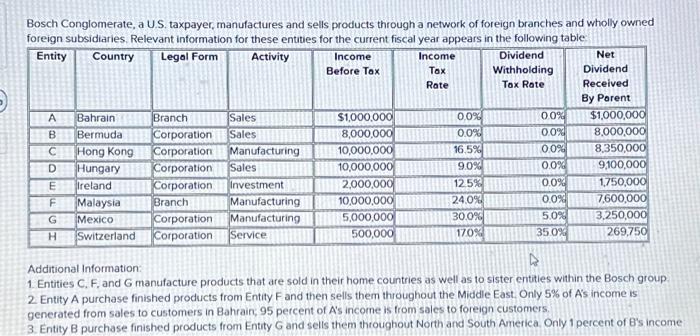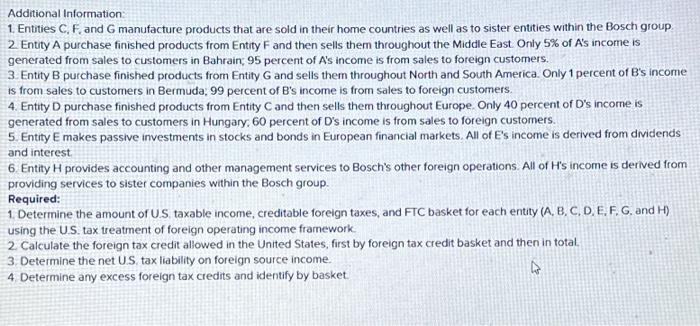Bosch Conglomerate, a U.S, taxpayer, manufactures and sells products through a network of foreign branches and wholly owned foreign subsidiaries. Relevant information for these entites for the current fiscal year appears in the following table: Additional Information: 1. Entities C. F, and G manufacture products that are sold in their home countries as well as to sister entities within the Bosch group. 2. Entity A purchase finished products from Entity F and then sells them throughout the Middle East. Only 5% of A's income is generated from sales to customers in Bahrain, 95 percent of A's income is from sales to foreign customers. 3. Entity B purchase finished products from Entity G and selis them throughout North and South America. Only 1 percent of B's income Additional Information: 1. Entities C, F, and G manufacture products that are sold in their home countries as well as to sister entities within the Bosch group. 2. Entity A purchase finished products from Entity F and then sells them throughout the Middle East. Only 5% of A's income is generated from sales to customers in Bahrain; 95 percent of A's income is from sales to foreign customers. 3. Entity B purchase finished products from Entity G and sells them throughout North and South America. Only 1 percent of B's income is from sales to customers in Bermuda; 99 percent of B's income is from sales to foreign customers. 4. Entity D purchase finished products from Entity C and then sells them throughout Europe. Only 40 percent of D's income is generated from sales to customers in Hungary, 60 percent of D's income is from sales to foreign customers. 5. Entity E makes passive investments in stocks and bonds in European financial markets. All of E's income is derived from dividends and interest. 6. Entity H provides accounting and other management services to Bosch's other foreign operations. All of H's income is derived from providing services to sister companies within the Bosch group. Required: 1. Determine the amount of U.S, taxable income, creditable foreign taxes, and FTC basket for each entity (A,B,C, D, E, F, G, and H) using the U.S. tax treatment of foreign operating income framework 2. Calculate the foreign tax credit allowed in the United States, first by foreign tax credit basket and then in total. 3. Determine the net U.S, tax liability on foreign source income. 4. Determine any excess foreign tax credits and identify by basket








